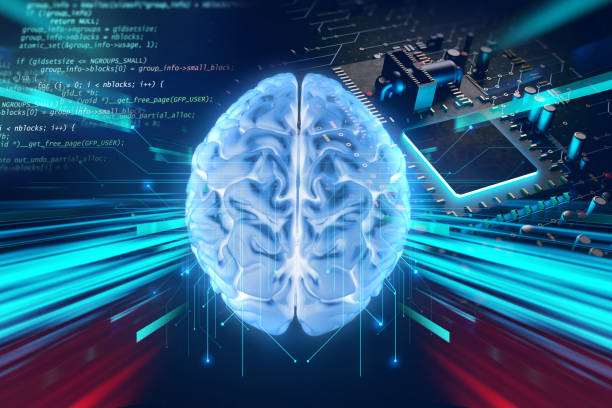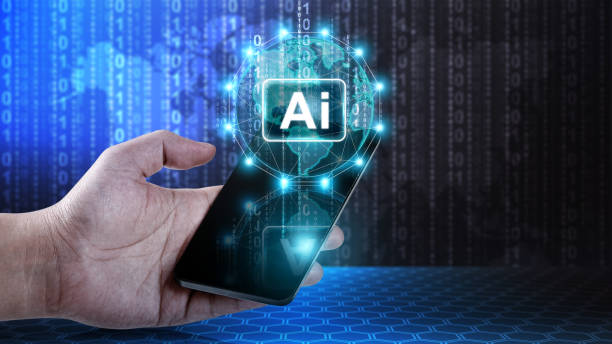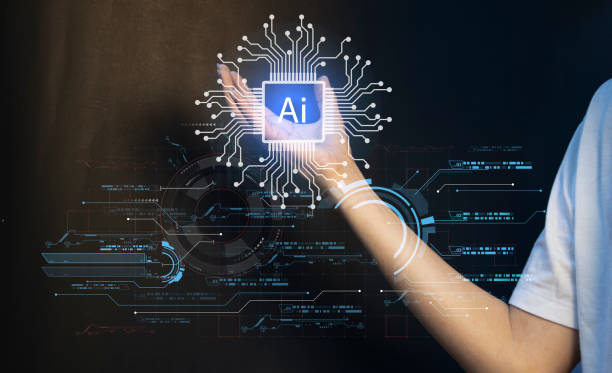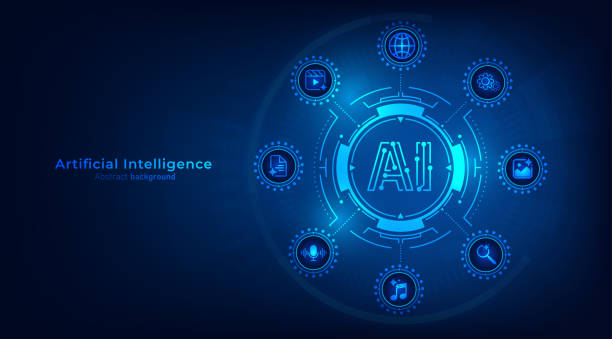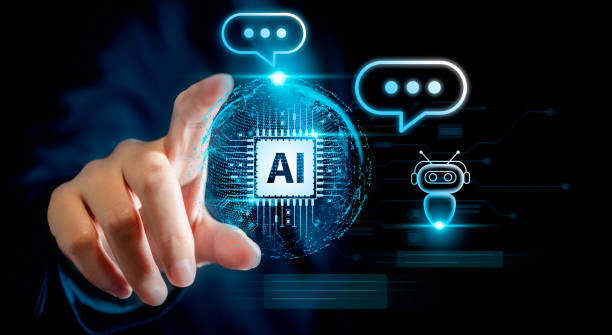What is Artificial Intelligence and How Does it Work?
#ArtificialIntelligence (AI) is a branch of computer science that deals with building machines that are capable of performing tasks that typically require human intelligence.
These tasks include learning, reasoning, problem-solving, understanding natural language, and pattern recognition.
AI attempts to model human cognitive processes and implement them in computer systems.
AI uses various algorithms and models to accomplish these tasks, including:
- Machine Learning: This method allows machines to learn from data without explicit programming.
Machine learning algorithms identify patterns in data and use them for prediction or decision-making. - Neural Networks: These models are inspired by the structure of the human brain and consist of multiple layers of interconnected nodes.
Neural networks are used for tasks such as image recognition, natural language processing, and time series prediction. - Natural Language Processing: This branch of AI helps machines understand and generate human language.
Natural language processing includes tasks such as machine translation, sentiment analysis, and answering questions. - Expert Systems: These systems store the knowledge of a human expert in a specific domain and use it to provide advice or make decisions.
AI is rapidly advancing and has applications in many fields, including:
- Medicine: Disease diagnosis, drug development, robotic surgery
- Finance: Fraud detection, risk management, algorithmic trading
- Transportation: Self-driving cars, traffic optimization
- Manufacturing: Automation of production lines, quality control
- Customer Service: Chatbots, answering customer questions
However, AI also has challenges, including concerns about ethics, privacy, and security.
Responsible and ethical development of AI is essential to ensure that this technology is used for the benefit of all humans.
For a better understanding of artificial intelligence, you can visit Wikipedia.
Does your current website convert visitors into customers or drive them away? Solve this problem forever with a professional company website design by Rasaweb!
✅ Create a powerful brand and credibility
✅ Attract target customers and increase sales
⚡ Get a free consultation now!
Types of AI Based on Capability
AI can be divided into several main categories based on capability:
- Narrow or Weak AI: This type of AI is designed to perform a specific task and cannot function outside of that task.
Examples of weak AI include facial recognition systems, search engines, and recommender systems.
Most AI systems today fall into this category. - General or Strong AI: This type of AI has intelligence equivalent to or greater than human intelligence and can perform any task that a human can perform.
Strong AI is still in the research and development phase and has not yet become a reality. - Super AI: This type of AI surpasses human intelligence and can outperform humans in all areas.
Super AI is a hypothetical concept and has not yet become a reality.
The main difference between these types of AI is their level of generalizability and flexibility.
Weak AI can only perform a specific task, while strong AI can perform any task, and super AI can surpass human intelligence.
To start learning AI, you can use the educational websites Maktabkhooneh and Faradars.
The development of strong and super AI poses many technical and ethical challenges.
Some of these challenges include:
- Developing General Learning Algorithms: To build strong AI, we need algorithms that can learn from diverse data and generalize their knowledge to new tasks.
- Understanding and Modeling Consciousness: Consciousness is a complex phenomenon that is not yet fully understood.
To build strong AI, we need to understand and model consciousness. - Control and Safety: As the power of AI increases, ensuring that this technology is used for the benefit of humans and does not pose a threat to them becomes more important.
Machine Learning and its Role in Artificial Intelligence
Machine Learning is one of the main sub-branches of #ArtificialIntelligence and allows machines to learn from data without explicit programming.
In fact, instead of giving machines precise instructions for performing a task, they are given data from which to extract patterns and relationships.
Machine learning algorithms are divided into different categories based on the type of learning:
- Supervised Learning: In this type of learning, the machine is given labeled data, meaning that the correct answer is specified for each piece of data.
The machine learns from this data to be able to predict the correct answer for new data.
Examples of supervised learning include regression and classification. - Unsupervised Learning: In this type of learning, the machine is given unlabeled data.
The machine learns from this data to discover hidden patterns and structures.
Examples of unsupervised learning include clustering and dimensionality reduction. - Reinforcement Learning: In this type of learning, the machine interacts with its environment and learns based on the feedback it receives to find the best strategy for achieving its goal.
Examples of reinforcement learning include playing games and controlling robots.
Click here to preview your posts with PRO themes ››
Machine learning plays a very important role in the development of AI.
Many AI systems today use machine learning algorithms to perform various tasks, including:
- Image Recognition: Face recognition, object recognition in images
- Natural Language Processing: Machine translation, sentiment analysis, answering questions
- Recommender Systems: Suggesting products, suggesting movies, suggesting articles
- Self-Driving Cars: Obstacle detection, navigation, car control
Here is a table comparing different types of machine learning algorithms:
| Learning Type | Description | Example |
|---|---|---|
| Supervised | Learning from labeled data | Regression, classification |
| Unsupervised | Learning from unlabeled data | Clustering, dimensionality reduction |
| Reinforcement | Learning through interaction with the environment | Playing games, controlling robots |
Deep Learning and its Applications
Deep Learning is a type of machine learning that uses neural networks with multiple layers.
These layers allow machines to learn more complex patterns in data.
Deep learning has made remarkable progress in recent years and has achieved very good results in many fields.
These advances are mainly due to the increase in the volume of available data and the increase in the processing power of computers.
AI also benefits from this power.
Some applications of deep learning include:
- Image Recognition: Deep neural networks have very high accuracy in image recognition and can correctly recognize images that humans have difficulty recognizing.
- Natural Language Processing: Deep neural networks have also been very successful in natural language processing and can translate texts, answer questions, and even generate new texts.
- Speech Recognition: Deep neural networks are also very accurate in speech recognition and can convert speech to text.
- Self-Driving Cars: Deep neural networks are used in self-driving cars to detect obstacles, navigate, and control the car.
One of the most famous examples of deep neural networks is Convolutional Neural Networks (CNNs), which are specifically designed for processing images.
Recurrent Neural Networks (RNNs) are also used for processing sequential data such as text and speech.
However, deep neural networks also have challenges.
One of these challenges is that training these networks requires a lot of data.
Another challenge is that deep neural networks often act like a black box, and it is difficult to understand how they arrived at a particular result.
How much does losing business leads due to an unprofessional website cost you? Solve this problem forever with a professional company website design by Rasaweb!
✅ Increase credibility and trust of potential customers
✅ Easier attraction of new business leads
⚡ Get a free consultation now!
Natural Language Processing (NLP) and its Applications
Natural Language Processing (NLP) is a branch of #ArtificialIntelligence that allows machines to understand and generate human language.
The main goal of NLP is to enable machines to communicate with humans in natural language.
AI plays a role in NLP.
NLP uses various techniques to process human language, including:
- Syntax Analysis: This technique helps machines understand the structure of sentences.
- Semantic Analysis: This technique helps machines understand the meaning of words and sentences.
- Discourse Analysis: This technique helps machines understand the relationship between sentences in a text.
Some applications of NLP include:
- Machine Translation: Translating texts from one language to another
- Sentiment Analysis: Detecting emotions in a text
- Question Answering: Answering questions posed in natural language
- Chatbots: Creating programs that can converse with humans in natural language
- Text Summarization: Generating short summaries of long texts
NLP has made remarkable progress in recent years and has achieved very good results in many fields.
These advances are mainly due to the development of machine learning algorithms and the increase in the volume of available data.
For example, modern machine translation systems can translate texts with very high accuracy.
Chatbots are also increasingly used in customer service and can answer many customer questions.
Robotics and Artificial Intelligence
Robotics is a branch of engineering that deals with the design, construction, operation, and application of robots.
#ArtificialIntelligence plays a very important role in robotics because it allows robots to act more intelligently and independently.
AI allows robots to understand their environment, make decisions, and perform complex tasks.
AI-equipped robots can be used in many fields, including:
- Manufacturing: Robots can be used in production lines to perform repetitive and dangerous tasks.
- Medicine: Robots can be used in surgery, rehabilitation, and patient care.
- Services: Robots can be used in restaurants, hotels, and stores to provide services to customers.
- Exploration: Robots can be used in dangerous environments such as mines, contaminated areas, and space for exploration and information gathering.
Click here to preview your posts with PRO themes ››
Some examples of AI-equipped robots include:
- Self-Driving Cars: Cars that can drive without human intervention.
- Surgical Robots: Robots that can perform complex surgeries with high precision.
- Nursing Robots: Robots that can help patients with daily tasks.
- Exploration Robots: Robots that can explore dangerous environments.
The development of AI allows robots to act more intelligently and independently, and as a result, their applications are expanding in various fields.
Ethics in Artificial Intelligence
With the increasing expansion of #ArtificialIntelligence, ethical issues related to this technology are becoming more important.
AI can have profound impacts on society, and it is necessary for these impacts to be carefully examined.
Some important ethical issues in AI include:
- Discrimination: AI algorithms can be discriminatory if they are trained on data that contains discrimination.
This discrimination can occur in various areas such as hiring, lending, and criminal justice. - Privacy: AI systems often require a lot of personal information to function properly.
This information can be misused and violate people’s privacy. - Accountability: If an AI system makes a mistake, who is responsible? This is a question that still has no clear answer.
- Security: AI systems can be attacked and used for malicious purposes.
- Employment: AI can lead to job losses because many tasks can be done using robots and AI systems.
Here is a table that presents some of the ethical issues of AI along with potential solutions to address them:
| Ethical Issue | Potential Solution |
|---|---|
| Discrimination | Using diverse and non-discriminatory data, developing fair algorithms |
| Privacy | Protecting personal information, transparency about how information is used |
| Accountability | Determining accountability in case of errors, developing safe and reliable systems |
| Security | Protecting AI systems against attacks, developing fault-tolerant systems |
The Future of Artificial Intelligence
The future of #ArtificialIntelligence looks very bright.
AI is rapidly advancing, and it is expected to have a more profound impact on society in the coming years.
Some important trends in AI include:
- Increased Processing Power: The processing power of computers is rapidly increasing, which helps in the development of more complex AI algorithms.
- Increased Data Volume: The volume of available data is rapidly increasing, which helps machine learning algorithms learn better.
- Development of New Algorithms: New AI algorithms are constantly being developed, which allows machines to perform more complex tasks.
- Expansion of Applications: The applications of AI are rapidly expanding, and it is expected to be used in various fields such as medicine, transportation, manufacturing, and customer service in the coming years.
However, the development of AI also has challenges.
One of these challenges is that AI can lead to job losses.
Another challenge is that AI can be misused and used for malicious purposes.
Are you worried that your company’s old website is driving away new customers? Rasaweb solves this problem by designing a modern and efficient company website.
✅ Increases your brand credibility.
✅ Helps attract targeted customers.
⚡ Contact Rasaweb for a free consultation!
Artificial Intelligence and Business
#Artificial Intelligence has had a profound impact on businesses.
AI can help businesses become more efficient, innovative, and competitive.
Some applications of AI in business include:
- Automation: AI can be used to automate many repetitive and tedious tasks.
This allows employees to focus on more important and creative tasks. - Data Analysis: AI can be used to analyze large volumes of data.
This helps businesses gain valuable insights from their data and make better decisions. - Customer Service: AI can be used to provide better customer service.
Chatbots and automated response systems can answer customer questions and solve their problems. - Marketing: AI can be used for more targeted marketing.
Recommender systems can suggest products and services to customers that they are likely to be interested in. - Risk Management: AI can be used for better risk management.
Fraud detection systems can identify fraud and prevent financial losses.
Businesses that use AI can gain many benefits, including:
- Increased Productivity
- Reduced Costs
- Improved Customer Service
- Increased Revenue
- Competitive Advantage
How to Learn Artificial Intelligence?
Learning #ArtificialIntelligence can be a challenging but very rewarding experience.
AI is a vast and complex field, but with effort and perseverance, you can learn the basics and progress in this area.
Here are some tips for learning AI:
- Start with the Basics: Before moving on to advanced topics, make sure you understand the basics of AI, such as machine learning, neural networks, and natural language processing.
- Use Online Resources: There are many online resources for learning AI, including courses, tutorials, books, and articles.
Use these resources to learn new concepts and practice your skills. - Attend Training Courses: Attending AI training courses can help you understand concepts more deeply and connect with experts in the field.
- Do Practical Projects: The best way to learn AI is to do practical projects.
By doing practical projects, you can apply concepts in practice and strengthen your skills. - Join AI Communities: Joining AI communities can help you connect with other people interested in this field, learn from their experiences, and stay informed about the latest developments in this area.
Click here to preview your posts with PRO themes ››
Some useful online resources for learning AI include:
- Coursera
- edX
- Udacity
- Fast.ai
- Kaggle
Frequently Asked Questions
| Question | Answer |
|---|---|
| What is the definition of هوش مصنوعی (Artificial Intelligence)? | It is a field in computer science that aims to create intelligent machines that can think, learn, solve problems, and make decisions like humans. |
| Mention some common artificial intelligence applications. | Includes self-driving cars, voice assistants (such as Siri and Alexa), recommendation systems (such as Netflix and Amazon), facial recognition, and medical diagnosis. |
| What is the difference between Narrow AI (ANI) and General AI (AGI)? | Narrow AI is specialized in one specific task, while General AI possesses human intellectual ability to perform any cognitive task. |
| What is Machine Learning and how does it relate to Artificial Intelligence? | Machine learning is a branch of artificial intelligence that focuses on developing algorithms that allow systems to learn from data without explicit programming. |
| What are Artificial Neural Networks? | They are computational models inspired by the structure and function of the human brain, used in deep learning to process data and discover complex patterns. |
| Mention some ethical challenges related to artificial intelligence. | Includes issues of privacy, bias in data and algorithms, job loss, and responsibility in case of errors or unfair decisions. |
| What is Natural Language Processing (NLP)? | It is a branch of artificial intelligence that focuses on enabling computers to understand, interpret, and generate human language in a useful and interactive way. |
| How can artificial intelligence affect the labor market? | It can lead to the automation of some routine tasks, requiring retraining of workers and creating new jobs in the fields of design, development, and maintenance of artificial intelligence systems. |
| What is Computer Vision? | It is a field in artificial intelligence that enables computers to “see,” understand, and interpret images and videos in the same way that humans do, enabling them to recognize objects and faces. |
| What is the importance of data in the development of artificial intelligence systems? | Data is the fuel that feeds artificial intelligence systems, especially in machine learning. The quality and quantity of data greatly affect the accuracy and performance of models and their ability to learn and make the right decisions. |
And other services of Rasa Web Advertising Agency in the field of advertising
Intelligent Sales Automation: A creative platform to improve click-through rate by optimizing key pages.
Intelligent Sales Automation: A quick and efficient solution to increase click-through rates by focusing on attractive user interface design.
Intelligent Digital Branding: Professional optimization to increase click-through rate by using user experience customization.
Intelligent Digital Branding: A quick and efficient solution to increase site visits by focusing on intelligent data analysis.
Intelligent Reportage: An effective tool to increase sales with the help of intelligent data analysis.
And more than hundreds of other services in the field of internet advertising, advertising consulting and organizational solutions
Internet Advertising | Advertising Strategy | Reportage Advertising
Resources
What is Artificial Intelligence and What are its Applications?
,What is Artificial Intelligence (Artificial Intelligence)? — In Simple Terms
,What is Artificial Intelligence? How Does Artificial Intelligence Work?
,What is Artificial Intelligence? What are its Applications, Advantages and Disadvantages?
? Ready to transform your business in the digital world? Rasa Web Digital Marketing Agency, offering comprehensive and innovative solutions, is with you on the path to success. For a sustainable growth experience, from **Website design with a modern user interface** to SEO strategies and targeted advertising campaigns, contact us.
📍 Tehran, Mirdamad Street, next to the Central Bank, South Kazerun Alley, Ramin Alley, No. 6
“`

